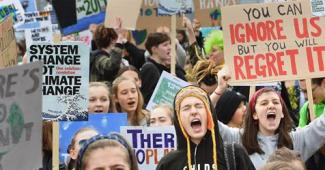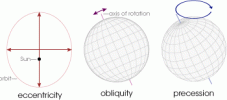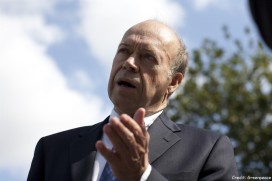
Normally during a total lunar eclipse, like this one on April 15, 2014, you can still see the moon, but in 1963 Jim Hansen saw it disappear completely. Explaining why would send him on a scientific journey to Venus, before coming back down to Earth. Image credit: NASA
Jim Hansen’s life changed on the evening the moon disappeared completely. In a building in a cornfield Jim and fellow University of Iowa students Andy Lacis and John Zink, and their professor Satoshi Matsushima, peered in surprise through a small telescope into the wintry sky. It was December 1963, and they had seen the moon replaced by a black, starless circle during a lunar eclipse. The moon always passes into Earth’s shadow during such eclipses, but usually you can still see it.
At first they were confused, but then they remembered that in March there had been a big volcanic eruption. Mount Agung in Indonesia had thrown tonnes of dust and chemicals into the air: perhaps that was blocking out the little light they’d normally have seen? With a spectrometer attached to their telescope they measured the moon’s brightness, data Jim would then base his first scientific research on. Using this record to work out the amount of ‘sulphate aerosol’ particles needed to make the moon disappear, Jim began a lifelong interest in planets’ atmospheres. That would lead him to become director of the NASA Goddard Institute of Space Studies (GISS), where he has led the way in exposing the threat from human CO2 emissions.
Jim was born in Iowa in 1941, the fifth of seven children of a farmer, who had left school at 14, and his wife. As he grew up they moved into the town of Denison, his father becoming a bartender and his mother a waitress, and Jim spending his time playing pool and basketball. Jim claims he wasn’t academic, but found maths and science the easiest subjects, always getting the best grades in them in his school. Though his parents divorced when he was young, public college wasn’t expensive at the time, meaning Jim could save enough money to go to the University of Iowa.
The university had an especially strong astronomy department, headed by James Van Allen, after whom brackets of space surrounding the Earth are named. These ‘Van Allen Belts’ are layers of particles that he discovered, held in place by the planet’s magnetic field. Satoshi Matsushima, a member of Van Allen’s department, could see Jim and Andy’s potential and convinced them to take exams to qualify for PhD degrees a year early. Both passed, with Jim getting one of the highest scores, and were offered NASA funding that covered all their costs.
A few months later, it was Satoshi who suggested measuring the eclipse’s brightness, feeding Jim’s interest in atmospheres on other planets. “Observing the lunar eclipse in 1963 forced me to think about aerosols in our atmosphere,” Jim told me. “That led to thinking about Venus aerosols.” In an undergraduate seminar course Jim had given a talk about the atmospheres of outer planets, which James Van Allen had attended. The elder scientist told him that recently measured data was suggesting Venus’ surface was very hot. Aerosols stopped light reaching the Earth during the eclipse – could they be warming up Venus by stopping heat escaping, Jim wondered? That would become the subject of his PhD, and Satoshi and James Van Allen would be his advisors. Read the rest of this entry »
 by Myles Allen, University of Oxford
by Myles Allen, University of Oxford












